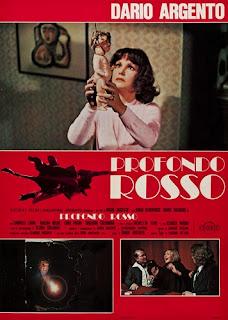
Whenever I think of Dario Argento’s 1975 giallo Deep Red, there’s one scene in particular that pops into my head. Occurring late in the film, it’s a sequence in which Professor Giordani (Glauco Mauri) is alone in his study. Suddenly, a creepy mechanized doll, the size of a small child, comes walking through the door towards him. The doll sports a sinister grin, and approaches at a hurried pace. Frightened, Giordani grabs a fireplace poker and smashes in the doll’s head. His relief at ridding himself of this threatening toy is only short-lived, however, and Giordani soon meets a violent, terrible end at the hands of the real killer.
It is, as I mentioned above, a memorable moment from a classic horror film, but seen in context with the rest of the movie it makes little sense. The doll serves no real purpose, except to possibly distract Giordani while the killer gets into position. But even this explanation feels like a stretch (from where the killer finally strikes, it’s doubtful he/she could have gotten there without Giordani seeing them). And yet the scene works as Argento intended, unnerving us almost as much as the intended victim, Giordani.
This is what separates Deep Red from its director’s earlier Animal Trilogy (Bird with the Crystal Plumage, Cat O’ Nine Tails, Four Flies on Grey Velvet). Like those films, this 1975 horror / thriller is undoubtedly a giallo, but one in which story and plot take a back seat to cinematic style.
Prior to his run-in with the doll, Giordani had been assisting the film’s lead character, British jazz musician Mark Daly (David Hemmings), who witnessed the murder of his neighbor, psychic Helga Ulmann (Macha Meril). The first on the scene after Helga is killed, Mark immediately calls the police, yet by the time they get there he is convinced one of the pictures that was hanging in Helga’s apartment when he first arrived has since disappeared. Unfortunately, he cannot recall which picture, or what image it contained.
Teaming up with reporter Gianna Brezzi (Daria Nicolodi), Mark spends the remainder of the movie trying to connect the dots, hoping to somehow remember the missing picture, which he believes might hold the key to revealing the killer’s identity.
It’s a standard giallo storyline, and actually has quite a bit in common with Argento’s first foray into the subgenre, The Bird with the Crystal Plumage. In addition, there are POV shots (from the killer’s perspective) scattered throughout the movie, and a central mystery that grows more perplexing as the story unfolds.
And yet Deep Red is more than a giallo; it is an exercise in style, with Argento utilizing sweeping camera movements, long shots (several early street scenes featuring Mark and his musician friend Carlo, played by Gabriele Lavia, are shot from a distance away), and moments of extreme violence (an author, played by Giuliana Calandra, meets a particularly gruesome end in a tub of scolding hot water). There is also an extended, expertly shot sequence in which Mark investigates an abandoned house, where he makes several startling discoveries.
Other themes and subtexts are featured throughout Deep Red as well, including the “battle of the sexes” that develops between Marc and Gianna Brezzi; along with a humorous scene in which Gianna challenges Mark to an arm-wrestling match, there’s the even funnier recurring image of Mark in the broken passenger’s seat of Gianna’s car, which, because it has collapsed onto the floor, makes him look like a child whenever they’re driving down the road. Argento also makes great use of the film’s superb musical score, composed by the band Goblin, whose work would reach legendary status in the director’s next film, 1977’s Suspiria.
More than anything, though, Deep Red is a bridge between the Argento of old - the master of the giallo - and the Argento yet to come, whose subsequent movies such as Suspiria, Opera, and Phenomena put the emphasis more on spectacle than narrative.
But Deep Red did more than just straddle the line between Argento’s distinct personalities. With its engaging central mystery combined with a plethora of cinematic bells and whistles, it ultimately proved to be the best of both its director’s worlds.
Rating: 9.5 out of 10
